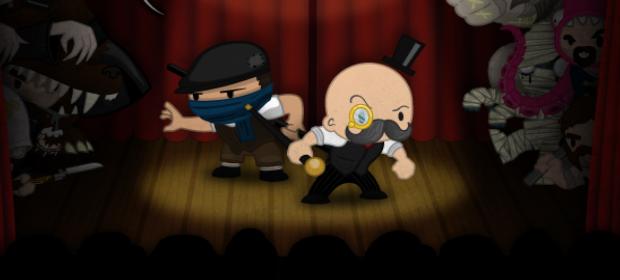Two Aggressors: one slightly annoyed Mummy, one short tempered Vampire. First, stun Mummy. Enraged, Vampire will launch into wild punch. Employ counter. Strike Vampire thrice before hurling toward Mummy. With both enemies airborne, intercept wall bounce with four combo strike before transition into ground cutter. Both enemies near death, deliver final series of ground slaps to conclude combat. Crowd satisfied. Combo perfect.
Now I don’t know if it’s just the gentlemanly Victorian stylings of Foul Play, but it genuinely feels as if someone at developers Mediatonic took a shine to the recent Guy Richie interpretation of Sherlock Holmes. It’s in Foul Play’s combat; it just feels so delicately designed around perfect flow, aggression and reaction that there’s a beautiful sort of science to this roaming brawler that harmlessly recalls Downey Jr’s measured thug dispatches.
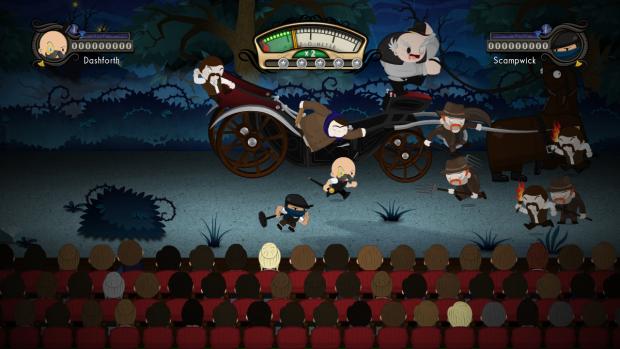
Based around the daemon hunter Baron Dashforth and his sidekick Scampwick, Foul Play adopts a theatrical presentation not a million miles away from the recently released “Puppeteer”. Essentially, you’re putting on a play for the denizens of ye olde London, recalling the globe-trotting, daemon-slaying adventures of Dashforth as scenery is moved around behind you and you fight against blokes wearing werewolf costumes.
It’s all endearingly silly, and while the setting lends itself well to comical asides (the janitor makes numerous appearances, touching up the set as the heroes come into scene), it’s the way this stage presentation is translated into gameplay that truly justifies it.
This is a roaming beat-em-up much in the flavour of Castle Crashers. There are many, many, many enemies in Foul Play and you have to beat them all up before you’re allowed onto the next stage. However, as you play the pugilist you’re “performing” for the audience. You don’t have a health bar, but instead an”audience” meter that displays how engaged everyone is with your act. Perform combos and the bar rises, get smacked and the bar drops. If the bar drops too far then the curtain falls and it’s game over. Perform well enough and the crowd will start whooping and hollering, hurling their hats into the air in jubilation as your score multiplier increases alongside their excitement.
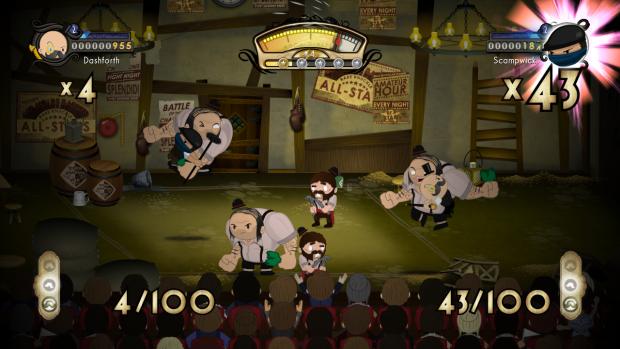
This is where Foul Play succeeds while other games of this ilk fall into repetition and monotony – the game has a strong focus on the combo, but an equally fierce appreciation for flow and choice. It will take a while for any player of Foul Play to realise this as techniques are locked behind a levelling up system, but once you achieve level 5 or 6 (of 12), the game’s potential and joys start to become clear.
It’s all about the counter. If you spy an enemy’s attack then a sharp tap of the B button (on Xbox 360) will engage a counter, and after levelling up a few times you’ll have a number of options when in a counter state. You can hurl the enemy away towards their friends, batter them up with a quick flurry, or perhaps pile-drive them down if there’s a group of foes below you. It might not sound like much but when you mix in Foul Play’s tight combo timer and the various enemy archetypes (small, flying, big, ranged), the second to second decisions in combat can make all the difference between an elegant “perfect scene” (beat a fight with one full, uninterrupted combo) and a sloppy, dropped attack string and a disgruntled audience.
It’s almost a shame that, at first, the very concept of a 50-hit combo seems like the stuff of fantasy, because after about 90 minutes or so of play, it becomes a very feasible, potentially regular reality. Heck, you can get up to 100 hits with a basic group of grunts once you’ve got a handle on the better tools.
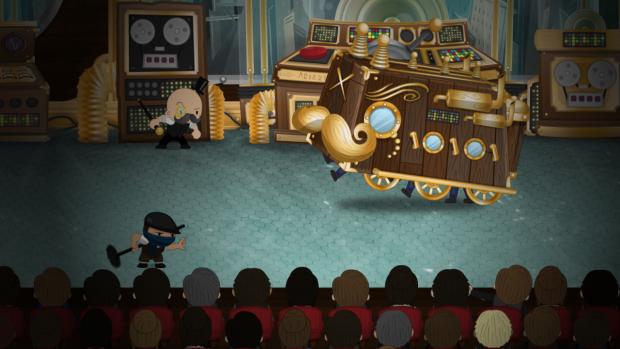
This wouldn’t be an issue if the game didn’t make you want to pull off (and make you think you should be able to pull off) some mega-sized combos from the start. Each main level in Foul Play has “challenges”, three optional tasks that push your abilities, often because the audience asks for it (Dashforth doesn’t want to upset his fans, after all). These tasks range from killing a specific enemy last to clearing a room in record time to, yup, landing a long combo. Finishing every challenge in a stage unlocks a Charm, and these Charms apply buffs (you can equip two Charms at a time), that lend further consideration towards earning those chunky high scores. Challenges feel more apt as the carrot for a second play, yet they’re thrust into your face from the start.
Not that you need to concern yourself with the challenges, or indeed the silly combos. Foul Play can just as easily be enjoyed for its campy narrative, silly presentation and reactive foe boshing. The game lasts about three hours on its first run, and is fun even without considering its complexities. But to say it’s replayable is an absolute understatement; this game is practically designed as a treadmill, with combat so entertaining and responsive that you could run the same stages again, and again, and again, and still find it to be solid, satisfying fun.

Foul Play also supports two player co-op both on and offline, so you’re sure to find buddies with whom to smash daemonic faces with. And y’know how I said that landing a perfect scene solo was fulfilling? Working as a perfect pair to craft a ballet of death is on another level entirely. Finding that perfect synergy with a partner as the crowd cheers and the combo counter blossoms into new colours creates a near euphoric sense of zen that the likes of Streets of Rage, and even Castle Crashers, have never considered. Simply put, Mediatonic have crafted one beauty of a fighting system.
Where Foul Play falls short is largely in its art. Castle Crashers sang through Dan Paladin’s unrivalled pen work, but Foul Play’s enemy designs tend to feel a little less inspired. At its best Foul Play is simply fine, and at its worst it evokes a lazy mid-90’s Newgrounds Flash animation type of stink, with some enemies just lacking any sort of interesting detail or flair.
Worst of all is when the game gets tricky on account of understated and occasionally clumsy design. An enemy’s attack is signposted by “signal” above their head, similar to the Arkham games, but this white flash can get lost in a large scrum of foes, leading to combo drops from invisible swings that should have been more obvious. It’s also easy to get lost behind foreground scenery. Screen estate is tight anyway, thanks to the audience, so these elements only make the play space more awkward.
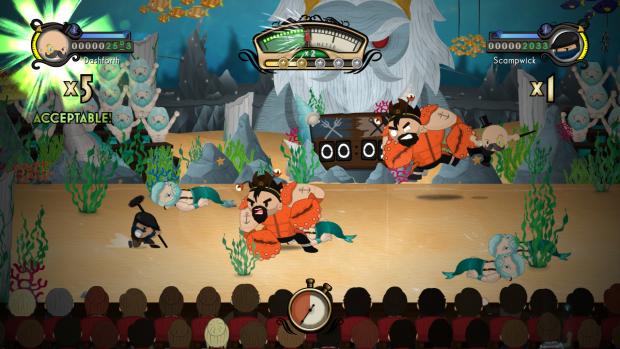
VERDICT: Visual shortcoming and questionable first impressions aside, Foul Play is a cheery, bright-eyed, delightful roaming beat-em-up that, through superior, fluid and engrossing combat mechanics, has arguably swiped the crown of Beat-’em-up King right off of Castle Crashers head.
Like some sort of game-design Sherlock Holmes, developers Mediatonic have analysed similar games, determined the shortcomings of their combat, and delivered a series of educated tweaks and additions to craft something altogether more satisfying and interesting. And when you consider that the crux of a good roaming beat-’em-up is weighted on the quality of its brawling, it’s easy to deduce that this review comes with the strongest of recommendations for Mediatonic’s dapper creation.

VERY GOOD. An 8/10 is only awarded to a game we consider truly worthy of your hard-earned cash. This game is only held back by a smattering of minor or middling issues and comes highly recommended.


